The Gambia
11th to 18th November 2022
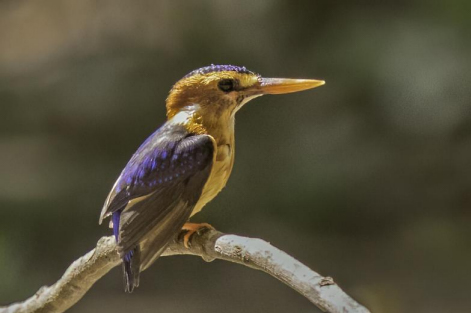
Tour Report
The Gambia
11th to 18th November 2022
Day 1: Friday, 11th November
Our tour started with an early morning flight from London Gatwick. Arrival at Banjul International Airport (Yundum) was near enough on time at 3.00 pm and from there it should have been no more than a half-hour journey to the Senegambia Beach Hotel at Kololi. However, major roadworks were in progress which more than doubled that time. No doubt the planned flyovers and multi-lane highway will much improve travel in the area in future but in the meantime the opposite is true and we would find ourselves delayed by this construction project on several occasions during our stay.
We checked in at around 5.30pm and after dropping the luggage in our rooms and quickly freshening up, we headed out into the gardens for a little birding before dark. The Senegambia gardens are an oasis of green in this part of The Gambia and attract a remarkable variety of birds. We managed to find 25 or more species in the short time available, including an African Scops Owl and the striking White-crowned Robin-Chat. We also started to get familiar with some of several quite similar-looking pigeon and dove species, many of which were seen every day.
Later, during dinner at the hotel’s Oasis Pool Restaurant, there were occasional glimpses of Gambian Fruit Bats.
Day 2: Saturday, 12th November
After our buffet breakfast, setting the routine for the week, we were collected from the hotel at 7.30 am by our guide, Karanta Camara, and driver, Modou.
After stopping on the way to buy bottles of drinking water, we went first to an area of woodland close to the village of Mandinaba about an hour away. Here we found a good variety of bird species that would soon become familiar to us. These included Beautiful, Splendid & Variable Sunbirds, Western Plantain-eater, Bronze Mannikin, Village Indigobird and Redcheeked Cordon-bleu, all of which were widespread and would be seen most days. Also here were Spotted Honeyguide, Brown-throated Wattle-eye and Fine-spotted Woodpecker that we saw on only this occasion.
At around 11.30 am we moved on to the nearby Farasuto Forest. Located on the southern banks of the Gambia River and covering only about 11 acres, this is among the few remaining patches of mature forest left in the whole of The Gambia. It transpires that the forest surrounding Farasuto was cut down, presumably for groundnut cultivation, in the late 1940s. The section which now remains as a bird reserve was apparently left as the place for ceremonial male and female circumcisions to be carried out and this appears to be the case for other small areas of remnant forest elsewhere in the country.
Blue-spotted Wood Dove was one of the first species seen, one of several that included Grey-backed Camaroptera and Black-rumped Waxbills, coming to a small pond. We also saw African Grey Woodpecker and African Paradise Flycatcher but soon we were joined by a local guide who took us to a wetland area where Giant & Pied Kingfishers, Hamerkop, Senegal Thick-knee, Western Reef Heron and African Wattled Lapwing were all seen. This was while he was trying to locate a White-backed Night Heron in a regular roost in dense vegetation. Eventually, he found it and we all got to see at least a part of it through a telescope. This wasn’t great but it was a typical view of this nocturnal species. Overhead there were Fanti Saw-wings, Mottled Spinetail, Bluecheeked Bee-eaters and a Shikra.

We returned to our vehicle on a promise that we would be driving to see two owl species! As it turned out, we were parked within walking distance of one of them, a Northern White-faced Owl. Then we did have to drive to see a pair of Greyish Eagle Owls – they were quite approachable and seemed habituated to visiting birdwatchers.
Finally, before lunch, we spent a few minutes in a hide that overlooks three small ponds where Black-rumped Waxbills, Red-cheeked Cordon-bleu and Red-billed Firefinch could probably have been predicted as the most likely visitors. There was also a Black-billed Wood Dove but the star bird was an African Pygmy Kingfisher.
We had lunch at Sita Joyeh Island Resort, which as its name suggests, we reached by boat. It was very pleasant with huge trees from which it got its alternative name 'Baobab Island'. There was then quite a long wait for the food to be served but it was good and by now we were anyway glad of some shade and respite from the heat – temperatures up to about 33ºC were normal by midday. From the window of the dining area there were close views of a Whimbrel and a Western Reef Heron. After lunch a Woodland Kingfisher and a Yellow-fronted Tinkerbird were seen on our way to the return boat.
Next we drove to nearby Pirang Woods, another small remnant of the once extensive forests that once covered The Gambia. Although this site boasts an impressive bird list, sadly we saw very little here and it was disappointing that when we did find a Verreaux’s Eagle Owl, not all of us got to see it before it flew out of sight. Karanta suggested that it had been disturbed by a group of Red Colobus Monkeys that we had seen minutes before. Back at the Senegambia Hotel dinner was accompanied by live music, pleasant enough but not conducive to conversation or ticking off the day’s birds.
Day 3: Sunday, 13th November
Our destination this morning was Brufut Woods requiring a journey of less than half an hour from our hotel. The reserve is managed by the West African Bird Study Association in collaboration with the local community and protects a tiny pocket of dense coastal forest and open woodland.
As we entered the site on foot we passed by an extensive vegetable garden area where we had close views of Hooded Vultures on the ground and we watched Western Red-billed Hornbill, African Mourning Dove and Lesser Blue-eared Glossy Starlings. In a distant tree, first one and eventually two Violet Turacos were spotted and we watched them for quite a while. A Lanner Falcon passed overhead followed soon after by a Shikra. As we moved on we saw Broad-billed Roller, Yellow-billed Shrike, Fanti Saw-wing and Western Plantain-eater and two more (or possibly the same two) Violet Turacos, which now came much nearer. A party of eight Green Wood-hoopoes hurried past us and we had our first sightings of Black-winged Red Bishop and Little Weaver.
Similar to yesterday, we were taken to an area where small ponds have been created to attract birds to drink and bathe. We sat and watched for a while but soon became impatient for more than doves, even if there were three or four different species.
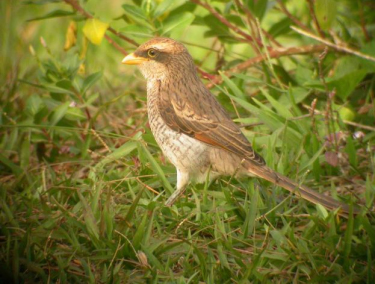
Again there was a locally-based guide who knew exactly where to find his ‘star’ species. This time it was a Long-tailed Nightjar and one by one we were ushered into a location from where the roosting bird could be seen well at quite close range.
Next there was a Northern Puffback and then good views of a Black-crowned Tchagra singing sweetly. Slightly less impressive was the song of a Whistling Cisticola but without the song (or Karanta) we may have struggled to distinguish the bird from several similar species. We paid another visit to the ponds but with no greater success. It was described as ‘a load of laughs’ and it’s true to say that Laughing Doves were by far the most numerous drinkers. A Bearded Barbet was seen (but only high in a tree) and an African Pied Hornbill was seen very briefly in flight. During the walk back to our vehicle we saw our first Levaillant’s Cuckoo and a Little Bee-eater flew high overhead.
Now it was lunchtime and we drove to Tanji, a nearby fishing village, where we went to a restaurant to order our food and then, while it was being cooked, we walked down to the beach to look at gulls and terns. Most of the gulls were Grey-headed but there were also a few Lesser Black-backs and a couple of Black-headed. Eventually we also found a single Slenderbilled. The terns were all Caspian and Sandwich Terns but we did give close attention to one that had an unusual pale bill that for just a short while promised to be something else. Also seen were Osprey, Pied Kingfisher, Pink-backed Pelican, Ruddy Turnstone and Black Kite. After an excellent lunch, we spent the rest of the afternoon at Tanji Bird Reserve, just a short drive away, north of the village. The reserve comprises dry woodland and coastal dune scrub woodland and also has some wetland areas. We had quite a long walk that took us to one of the lagoons. An Osprey and a Lizard Buzzard were among the first birds to get our attention and we soon saw the only Swallow-tailed Bee-eaters of the week, three birds that allowed quite close approach. Overhead were Pallid & African Palm Swifts.
Karanta was intent on finding Fourbanded Sandgrouse; several were flushed from the long grass and eventually we found some that didn’t immediately fly and we had good views. These attractive birds are said to be mostly nocturnal.
Stone Partridges proved to be less cooperative! This was just one of several occasions when we heard these birds calling quite loudly from dense vegetation only a short distance away but no matter how much whistling Karanta did, they would not show themselves.
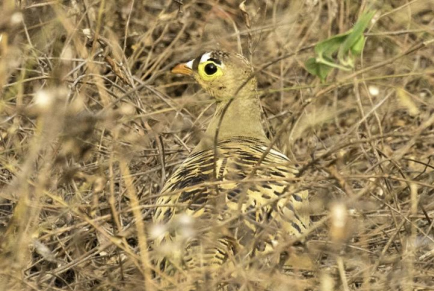
Broad-billed Roller, African Harrier-Hawk, Bearded Barbet and Little Bee-eater were other notable species seen here. When we finally reached the lagoon two Black Crakes eventually showed themselves and there were also brief appearances by Shikra, African Grey Hornbill, Spur-winged Lapwing and Long-tailed Cormorant.
During the walk back to the vehicle we saw probably a dozen or more Four-banded Sandgrouse. Most of them flushed but at least two showed well and were photographed. At about 4.30 pm we headed back to the Senegambia and spent the last half an hour of remaining daylight birding in the hotel grounds. There was nothing we hadn’t seen before but two White-crowned Robin Chats showed well.
Day 4: Monday, 14th November
We checked out of the hotel this morning and at 7.45 am set off on a three-day (two-night) excursion upriver. We were heading for Morgan Kunda Lodge, located on the north side of the Gambia River but we would be taking a route along the south side of the river to avoid the need for a time-consuming ferry crossing. The plan was to make several stops on the way for birding and to arrive at the lodge in time for lunch.
After a stop in Mandinaba to buy water, our first birding was at Mendy Kunda Woods. Here we actually concentrated on an open area where most of the trees had been cleared. A pair of White-fronted Black Chats and a Whinchat were species well-suited to the habitat that provided numerous low perches; a Striped Kingfisher was perhaps less expected. The surrounding trees held Vieillot’s Barbets, Rufous-crowned Roller, and Senegal Batis, Redwinged Warbler, Brubru, Yellow-fronted Canary and sunbirds that for the first time included Scarlet-chested. Also for the first time we saw Dark Chanting Goshawk and Short-winged (aka Siffling) Cisticola, another of this non-descript family best identified from its song. Our continuing journey was punctuated by numerous stops at police checkpoints as well as several ‘emergency stops’ for roadside birds that included Grasshopper Buzzard, Bateleur and Brown Snake Eagle.
Eventually, after passing through the town of Soma, we reached the Senegambia Bridge that took us across the Gambia River to the north. This bridge was opened in 2019 and replaced a ferry service that was extremely busy and prone to lengthy delays. The road is a major route that connects not only the north and south of The Gambia but also the main part of Senegal with that country’s southern province of Casamance.
Further stops included one for a bird that was thought at the time to be an Exclamatory Paradise Whydah but which was subsequently identified by Karanta (from photographs) as a Sahel Paradise Whydah. Both species have extraordinary elongated central tail feathers and are very similar but the tail of the Sahel is slightly shorter. Otherwise, there seems to be little difference between them. Both are brood parasites - one parasitises Red-winged Pytilias and the other Green-winged Pytilias.
Our last stop before lunch was at a waterhole where Karanta had recently seen Spotted Thickknees. Here we had a short walk and before long saw two of these birds as well as Red-billed Queleas, Black-rumped Waxbills and another Dark Chanting Goshawk.
We finally arrived at Morgan Kunda Lodge at 3.00 pm. The lodge was opened in 2016 to provide a source of income to fund the local school built by the Morgan Clark Foundation in the village of Jarjari. Staff come from the village. The accommodation is fairly basic but adequate and as good as any away from the coastal tourist area.
After we had eaten we took just a short drive before heading off on foot along a sandy track through dry thornscrub habitat that proved particularly productive. Highlights included Snowy-crowned Robin Chat, Northern Black Flycatcher, Greenwinged Pytilia, White-rumped Seedeater, White-billed Buffalo Weaver, Abyssinian Roller, Tawny-flanked Prinia, Black-headed Lapwing, Wahlberg’s Eagle, Bruce’s Green Pigeon and two Gabar Goshawks.
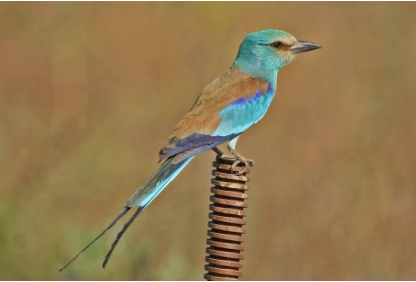
Day 5: Tuesday, 15th November
A later start this morning as we left the lodge at about 8.00 am. Unexpectedly, we began by heading west along the North Bank Road but only as far as the nearby Bao Bolong Reserve. Karanta had received a report that five Black Crowned Cranes had been seen there recently but we had no success in finding them in this vast wetland area. However, there were plenty of other birds to see. Waders included Ruff, Common Sandpiper, Greenshank and Blackwinged Stilt; there were Grey-headed & Slender-billed Gulls; White-breasted Cormorants were nesting. These were in addition to the Pied Kingfisher, African Darter, Great Egret and Blackheaded Heron that could be expected in this habitat.
Eventually, we gave up and now headed east towards Kauur although, inevitably, there were a couple of stops along the way. The first of these produced an African-Hawk, two Purple Herons, two Red-necked Falcons and a Western Marsh Harrier. A later stop was to see a flock of 35 flying Woolly-necked Storks. When we reached the wetland at Kauur it was only a matter of a few minutes before we saw the day’s main target species: Egyptian Plover. There were two of them quite close to the road and they continued to go about their business unconcerned by our presence. Although they are sometimes referred to as ‘Crocodile Birds’, there does not seem to be any evidence to support the suggestion that these birds sometimes pick the teeth of gaping Crocodiles!
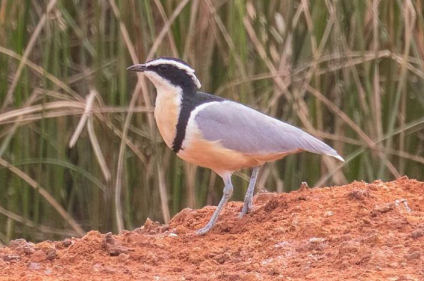
There were surprisingly few other waders here, just a Greenshank and a few Spur-winged Plovers. However, we did see Yellow Wagtails, a Hamerkop, a pair of Namaqua Doves, several Red-rumped Swallows and a Mosque Swallow. We set off back to Morgan Kunda Lodge at about 11.00 am. On the way we passed at least two Dark Chanting Goshawks perched by the roadside and we stopped when three Beaudouin’s Snake Eagles were seen in flight.
We also stopped for an hour or so at Girong Woods where Brown-rumped Bunting proved to be much more colourful bird than its name suggests. Amongst others also seen were European Bee-eater, Black Scimitarbill, Melodious Warbler, Senegal Parrot, Shikra, Chestnut-crowned Sparrow-Weaver, Brubru, White-fronted Black Chat and Wahlberg’s Eagle.
We were back at the lodge for lunch at 2.00 pm but out again later birding in a woodland area not far away. Here we saw mainly small birds - prinias, bishops and sunbirds but also raptors including African Harrier-Hawk and African Hawk- Eagle. At a small waterhole there were several Pied Kingfishers repeatedly diving for food, a Senegal Thick-knee and just a brief glimpse of a rather distant Cut-throat Finch.
Day 6: Wednesday, 16th November
After our two-night stay at Morgan Kunda Lodge we set off at about 8.00 am on our way back to the coast. Our journey would see us retracing the route we took on Monday. Our first stop this morning was at the northern end of the Senegambia Bridge. This was simply in order to take photographs of this impressive structure that has unfortunately taken away the livelihoods of many local people. No stop is without some birds, however, and here there was a Purple Glossy Starling and both Yellow & White Wagtails.
Next we had a short walk along the approach road to the bridge. With some heavy trucks passing which caused clouds of dust, it really wasn’t very pleasant but we had great views of a Blue-breasted Kingfisher. Also seen were Black-headed (aka Yellow-backed) Weavers but we struggled to get a good look at Winding Cisticolas.
The main event today was planned to be a boat trip and for this we went to Tendaba Camp, one of the oldest tourist facilities in the country away from the coast. It was established in 1972 in the days when the road journey upriver was quite an ordeal and most visitors reached Tendaba by boat from Banjul.
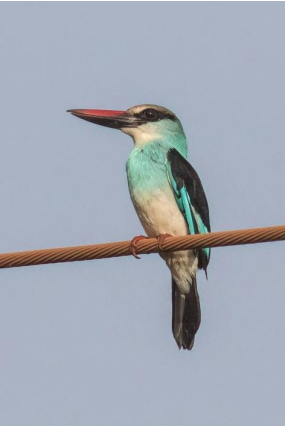
We arrived at Tendaba at 10.00 am, the appointed time for the boat trip but we had quite a long wait before we eventually boarded the boat. It was good to see Wandifa (Wandi) Touray, the local boatman/bird guide, back in action after a long period of illness; his experience and ability to find birds in the creeks and mangroves along the river is second to none. We began by going a short distance along the south side of the river before crossing to the north side where we spent the next two hours or more making our way along Kisi Bolon and Tunku Bolon, a circuit that eventually brought us back out onto the main river. Herons and egrets were plentiful, particularly Intermediate Egrets and Western Reef Herons and there were a great many nesting White-breasted Cormorants. African Darters were mostly perched with wings spread but some were in the water with just their snake-like head and neck showing. Woolly-necked Storks were quite numerous. Waders seen were mainly Whimbrels, Greenshanks and Common Sandpipers and there were frequent views of Pinkbacked Pelicans and Pied Kingfishers. A small flock of White-throated Bee-eaters was seen and there were several Brown Sunbirds, a mangrove specialist.
Undoubtedly the star species of the morning though was African Finfoot. This secretive bird is one we always hope to see on these boat trips and remarkably today we found two of them. Although the Finfoot bears a superficial resemblance to the grebes the two are not closely related and, as we saw, the Finfoot is quite adept out of water disappearing briefly among the mangrove roots on the muddy river bank.
Eventually, we crossed the river back to Tendaba and, as we approached the jetty, it was surprising to see how far the water level had fallen since we boarded the boat. Now we were faced with quite a climb to return to dry land.
After lunch we left Tendaba at about 3.00 pm to continue our journey back to the coast. There was just one stop on the way for further birding, at Bondali, but it was one that produced several species that we hadn’t previously encountered: Diederik Cuckoo, Copper Sunbird, White-shouldered Black Tit and Yellow White-eye. It would have been nice to stay here longer but we still had to travel more than 100km to reach our destination and inevitably when we did arrive at the hotel it was later than planned as a result of severe traffic congestion.
Day 7: Thursday, 17th November
Back at the Senegambia it was once again breakfast at 7.00 am and departure at 7.30 am. This morning we took the coast road passing through Tanji and continuing to Tujereng where we walked to a vantage point overlooking a substantial lagoon that held an excellent number and variety of birds. Highlights included Palm-nut Vulture, Giant & Malachite Kingfishers, Rednecked Falcon, White-faced Whistling Ducks, African Jacanas, Green-backed (Striated), Purple & Black-headed Herons, Wire-tailed Swallows and Senegal Thick-knees. Karanta had hoped to find African Pygmy Geese here and the extensive growth of water-lilies looked ideal for this species but we had no success.
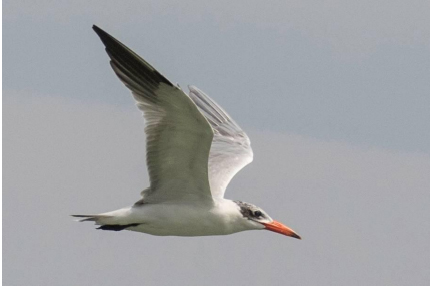
Next we drove further south to Kartong where there were more lagoons but still no Pygmy Geese. White-faced Whistling Ducks were numerous but apart from a Little Grebe the species present were ones that we had seen earlier. We walked to woodland nearby where we found several migrant species from Europe: Tree Pipit, Western Subalpine, Western Olivaceous & Melodious Warblers. Senegal Coucal, Blackcap Babbler and Yellow-billed Shrike were also seen and there were two or perhaps three Grey Kestrels.
Just a short drive took us to the Atlantic seashore where we had a walk along the sandy beach where we saw two White-fronted Plovers as well as Common Redshank and Ruddy Turnstone. In the distance we could see large numbers of gulls and terns and when we eventually reached them we found Common, Lesser Crested & West African Crested Terns as well as the more numerous Sandwich & Caspian Terns. Amongst the Grey-headed Gulls were Lesser Black-backs and Slender-billed Gulls. There were also Sanderlings, Whimbrels, a Bar-tailed Godwit, Oystercatchers, Little Egrets and Western Reef Herons. An Osprey circled overhead and subsequently its colourring enabled it to be identified from a photograph as a bird that had come from Germany to spend the winter months here.
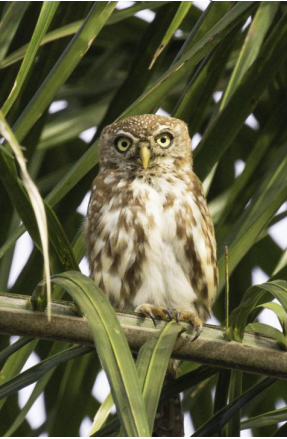
Eventually, we walked back and headed off to get lunch at the Rainbow Beach Bar. On the way we stopped when Yellow-billed Oxpeckers were spotted on roadside cattle. Eventually we counted eight of these birds and they proved to be the only ones seen during our tour. As usual, the lunch was very good but it took a while! Next we went to Kachume where a Black-winged Kite was the first bird we saw. We went on to find Four-banded Sandgrouse, Orange-billed & Lavender Waxbills, African Thrush, Black-crowned Tchagra and most notably a Pearlspotted Owlet. It was somewhat ironic that after listening to Karanta repeatedly imitating Pearl-spotted Owlet every day that this species was found only very late on our last full day of the tour.
Day 8: Friday, 18th November
This morning Karanta was tasked with providing us with a couple of hours local birding and having us back at the hotel by 10.00 am. This would enable us to finish packing and be ready to board the bus to the airport for our flight back to Gatwick.
The obvious strategy was to go to the Kotu area, just a ten-minute drive away. We started at the bridge that takes the road over Kotu Creek. For years this has been where tourists have come to find and hire a local bird guide. This is partly due to its proximity to several tourist hotels but also because it is a very good birding area. We walked a trail alongside the creek and saw mainly the expected wetland species. However, an Oriole Warbler skulking in dense vegetation was a treat when eventually seen well. Another skulker seen here was Yellowcrowned Gonolek. These colourful birds had been heard and sometimes glimpsed throughout the week but seldom showed well. A pair of Blackcaps also provided a late addition to our species list.
We walked through the local sewage farm, which has long been a ‘must visit’ birding site but now is sadly choked with vegetation that has rendered most of the lagoons unattractive to the wading birds that were once numerous here. There were about 80 Spur-winged Lapwings but little else to see.
After crossing the road we walked along what used to be known as the Casino Cycle Track, a track that runs behind the Badala Park Hotel. Several other birders were checking out a wetland area here but there was surprisingly little to see. A ‘scope view of a distant Black Heron was the highlight.
Our ten-minute journey back to the hotel took more than half an hour so it was as well that we had built some slack into our schedule. The problem was traffic congestion and security resulting from the Gambian President visiting the 5-star Kairaba Hotel which is located just across the road from the Senegambia. We actually had to park some way from the hotel and then walk the last 100m or so. It was here that we said goodbye to Karanta and Modou both of whom had been excellent throughout the tour.
Transport to the airport was provided by Gambia Experience. Our flight was due to depart at 4.00 pm but we left the hotel at midday allowing plenty of time to negotiate the roadworks. The flight was unremarkable and operated more or less as scheduled. By the time we had negotiated immigration formalities at Gatwick and picked up our bags it was after 11.00 pm.
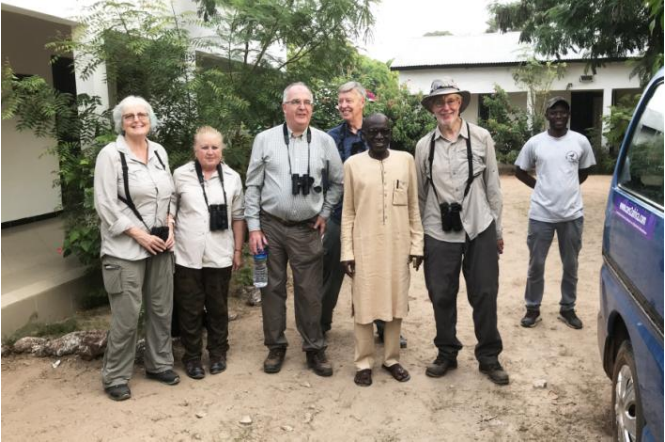
You can also have the wonderful experience from Gambia Birding Tours. To book your tour visit this link.
Bird List
Tachybaptus ruficollis
Great White Pelican
Pelecanus onocrotalus
Pink-backed Pelican
Pelecanus rufescens
Long-tailed Cormorant
Phalacrocorax africanus
White-breasted Cormorant
Phalacrocorax carbo lucidus
African Darter
Anhinga rufa
African Finfoot
Podica senegalensis
White-backed Night Heron
Gorsachius leuconotus
Green-backed Heron
Butorides striatus
Squacco Heron
Ardeola ralloides
Western Cattle Egret
Bubulcus ibis
Grey Heron
Ardea cinerea
Black-headed Heron
Ardea melanocephala
Purple Heron
Ardea purpurea
Great Egret
Ardea alba
Intermediate Egret
Egretta intermedia
Black Heron
Egretta ardesiaca
Western Reef Heron
Egretta gularis
Little Egret
Egretta garzetta
Hamerkop
Scopus umbretta
Yellow-billed Stork
Mycteria ibis
Woolly-necked Stork
Ciconia episcopus
White-faced Whistling Duck
Dendrocygna viduata
Western Osprey
Pandion haliaetus
Black-winged Kite
Elanus caeruleus
African Harrier Hawk
Polyboroides typus
Palm-nut Vulture
Gypohierax angolensis
Hooded Vulture
Necrosyrtes monachus
Beaudouin's Snake Eagle
Circaetus beaudouini
Brown Snake Eagle
Circaetus cinereus
Bateleur
Terathopius ecaudatus
Wahlberg's Eagle
Aquila wahlbergi
African Hawk Eagle
Aquila spilogaster
Lizard Buzzard
Kaupifalco monogrammicus
Gabar Goshawk
Micronisus gabar
Dark Chanting Goshawk
Melierax metabates
Shikra
Accipiter badius
Western Marsh Harrier
Circus aeruginosus
Black/Yellow-billed Kite
Milvus migrans migrans /parasitus
Grasshopper Buzzard
Butastur rufipennis
Eurasian Kestrel
Falco tinnunculus
Grey Kestrel
Falco ardosiaceus
Red-necked Falcon
Falco chicquera
Lanner Falcon
Falco biarmicus
Stone Partridge ♫♫
Ptilopachus petrosus
Double-spurred Francolin
Francolinus bicalcaratus
Black Crake
Amaurornis flavirostris
African Jacana
Actophilornis africanus
Egyptian Plover
Pluvianus aegyptius
Senegal Thick-knee
Burhinus senegalensis
Spotted Thick-knee
Burhinus capensis
Eurasian Oystercatcher
Haematopus ostralegus
Black-winged Stilt
Himantopus himantopus
Spur-winged Lapwing
Vanellus spinosus
Black-headed Lapwing
Vanellus tectus
African Wattled Lapwing
Vanellus senegallus
Grey Plover
Pluvialis squatarola
White-fronted Plover
Charadrius marginatus
Abyssinian Roller
Coracias abyssinica
Blue
-bellied Roller
Coracias cyanogaster
Broad
-billed Roller
Eurystomus glaucurus
Green Wood
-hoopoe
Phoeniculus purpureus
Black Scimitarbill
Rhinopomastus aterrimus
Western Red
-billed Hornbill
Tockus kempi
African Pied Hornbill
Tockus fasciatus
African Grey Hornbill
Tockus nasutus
Yellow
-fronted Tinkerbird
Pogoniulus chrysoconus
Vieillot's Barbet
Lybius vieilloti
Bearded Barbet
Lybius dubius
Spotted Honeyguide
Indicator maculator
Fine
-spotted Woodpecker
Campethera punctuligera
African Grey Woodpecker
Dendropicos goertae
Fanti Saw
-wing
Psalidoprocne obscura
Wire
-tailed Swallow
Hirundo smithii
Barn Swallow
Hirundo rustica
Red
-chested Swallow
Hirundo lucida
Mosque Swallow
Hirundo senegalensis
Red
-rumped Swallow
Hirundo daurica
Western Yellow Wagtail
Motacilla flava
White Wagtail
Motacilla alba
Tree Pipit
Anthus trivialis
Common Bulbul
Pycnonotus barbatus
African Thrush
Turdus pelios
Northern Black Flycatcher
Melaenornis edolioides
Snowy
-crowned Robin Chat
Cossypha niveicapilla
White
-crowned Robin Chat
Cossypha albicapilla
Whinchat
Saxicola rubetra
White
-fronted Black Chat
Myrmecocichla albifrons
Common Chiffchaff
Phyl
loscopus collybita
Sedge Warbler ♫♫
Acrocephalus schoenobaenus
Western Olivaceous Warbler
Hippolais opaca
Melodious Warbler
Hippolais polyglotta
Blackcap
Sylvia atricapilla
Western Subalpine Warbler
Curruca iberiae
Singing Cisticola ♫♫
Cisticola cantans
Whistling Cisticola
Cisticola lateralis
Winding Cisticola
Cisticola galactotes
Short
-winged Cisticola
Cisticola brachypterus
Tawny
-flanked Prinia
Prinia subflava
Red
-winged Prinia
Prinia erythropterus
Yellow
-breasted Apalis
Apalis flavida
Oriole Warbler
Hypergerus atriceps
Grey
-backed Camaroptera
Camaroptera brachyura
Red
-bellied Paradise Flycatcher
Terpsiphone rufiventer
African Paradise Flycatcher
Terpsiphone viridis
Senegal Batis
Batis senegalensis
Common Wattle
-eye
Platysteira cyanea
Brown Babbler
Turdoides plebejus
Blackcap Babbler
Turdoides reinwardtii
White
-shouldered Black Tit
Melaniparus leucomelas
Numenius phaeopus
Bar
-tailed Godwit
Limosa lapponica
Ruddy Turnstone
Arenaria interpres
Ruff
Calidris pugnax
Sanderling
Calidris alba
Common Sandpiper
Actitis hypoleucos
Common Redshank
Tringa totanus
Common Greenshank
Tringa nebularia
Slender
-billed Gull
Chroicocephalus genei
Black
-headed Gull
Chroicocephalus ridibundus
Grey
-headed Gull
Chroicocephalus cirrocephalus
Lesser Black
-backed Gull
Larus fuscus
Caspian Tern
Hydroprogne caspia
Lesser Crested Tern
Thalasseus bengalensis
West African Crested Tern
Thalasseus albididorsalis
Sandwich Tern
Sterna sandvicensis
Common Tern
Sterna hirundo
Feral Pigeon (Rock Dove)
Columba livia
Speckled Pigeon
Columba guinea
African Mourning Dove
Streptopelia decipiens
Red
-eyed Dove
Streptopelia semitorquata
Vinaceous Dove
Streptopelia vinacea
Laughing Dove
Streptopelia senegalensis
Black
-billed Wood Dove
Turtur abyssinicus
Blue
-spotted Wood Dove
Turtur afer
Namaqua Dove
Oena capensis
Bruce's Green Pigeon
Treron waalia
Four
-banded Sandgrouse
Pterocles quadricinctus
Senegal Parrot
Poicephalus senegalus
Rose
-ringed Parakeet
Psittacula krameri
Western Plantain
-eater
Crinifer piscator
Violet Turaco
Musophaga violacea
Senegal Coucal
Centropus senegalensis
Diederik Cuckoo
Chrysococcyx capreus
Klaas's Cuckoo ♫♫
Chrysococcyx klaas
Pearl
-spotted Owlet
Glaucidium perlatum
African Scops Owl
Otus senegalensis
Northern White
-faced Owl
Ptilopsis leucotis
Greyish Eagle Owl
Bubo cinerascens
Verreaux's Eagle Owl
Bubo lacteus
Long
-tailed Nightjar
Caprimulgus climacurus
Mottled Spinetail
Telacanthura ussheri
African Palm Swift
Cypsiurus parvus
Pallid Swift
Apus pallidus
Little Swift
Apus affinis
Striped Kingfisher
Halcyon chelicuti
Blue
-breasted Kingfisher
Halcyon malimbica
Woodland Kingfisher
Halcyon senegalensis
African Pygmy Kingfisher
Ispidina picta
Malachite Kingfisher
Alcedo cristata
Giant Kingfisher
Megaceryle maxima
Pied Kingfisher
Ceryle rudis
Swallow
-tailed Bee
-eater
Merops hirundineus
Little Bee
-eater
Merops pusillus
White
-throated Bee
-eater
Merops albicollis
Blue
-cheeked Bee
-eater
Merops persicus
European Bee
-eater
Merops apiaster
Rufous
-crowned Roller
Coracias naevia
Beautiful Sunbird
Cinnyris pulchellus
Splendid Sunbird
Cinnyris coccinigastrus
Variable Sunbird
Cinnyris venustus
Copper Sunbird
Cinnyris cupreus
Yellow-billed Shrike
Corvinella corvina
Sulphur-breasted Bush-shrike ♫♫
Telophorus sulfureopectus
Black-crowned Tchagra
Tchagra senegala
Northern Puffback
Dryoscopus gambensis
Yellow-crowned Gonolek
Laniarius barbarus
Brubru
Nilaus afer
Glossy-backed Drongo
Dicrurus divaricatus
Piapiac
Ptilostomus afer
Pied Crow
Corvus albus
Lesser Blue-eared Glossy Starling
Lamprotornis chloropterus
Bronze-tailed Glossy Starling
Lamprotornis chalcurus
Purple Glossy Starling
Lamprotornis purpureus
Long-tailed Glossy Starling
Lamprotornis caudatus
Yellow-billed Oxpecker
Buphagus africanus
Northern Grey-headed Sparrow
Passer griseus
House Sparrow
Passer domesticus
White-billed Buffalo Weaver
Bubalornis albirostris
Little Weaver
Ploceus luteolus
Black-necked Weaver
Ploceus nigricollis
Vitelline Masked Weaver
Ploceus vitellinus
Village Weaver
Ploceus cucullatus
Black-headed Weaver
Ploceus melanocephalus
Red-billed Quelea
Quelea quelea
Black-winged Red Bishop
Euplectes hordeaceus
Northern Red Bishop
Euplectes franciscanus
Bronze Mannikin
Lonchura cucullata
African Silverbill
Euodice cantans
Lavender Waxbill
Estrilda caerulescens
Orange-cheeked Waxbill
Estrilda melpoda
Black-rumped Waxbill
Estrilda troglodytes
Cut-throat
Amadina fasciata
Red-cheeked Cordonbleu
Uraeginthus bengalus
Green-winged Pytilia
Pytilia melba
Red-billed Firefinch
Lagonosticta senegala
Village Indigobird
Vidua chalybeata
Pin-tailed Whydah
Vidua macroura
Sahel Paradise Whydah
Vidua orientalis
White-rumped Seedeater
Crithagra leucopygia
Yellow-fronted Canary
Serinus mozambicus
Brown-rumped Bunting
Emberiza affinis
African Yellow White
-eye
Zosterops senegalensis
Brown Sunbird
Anthreptes gabonicus
Western Violet
-backed Sunbird
Anthreptes longuemarei
Collared Sunbird
Hedydipna collaris
Pygmy Sunbird
Hedydipna platura
Scarlet
-chested Sunbird
Chalcomitra senegalensis
♫♫ = heard only
Read aslo-
Gambia Tour Report, 2021
Gambia Tour Report Jan, 2022
Gambia Tour Report Jan, 2023